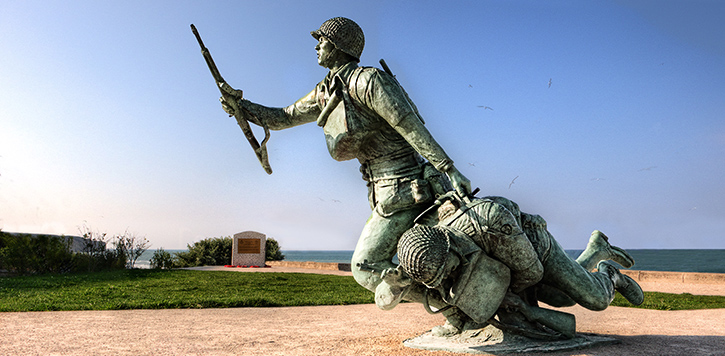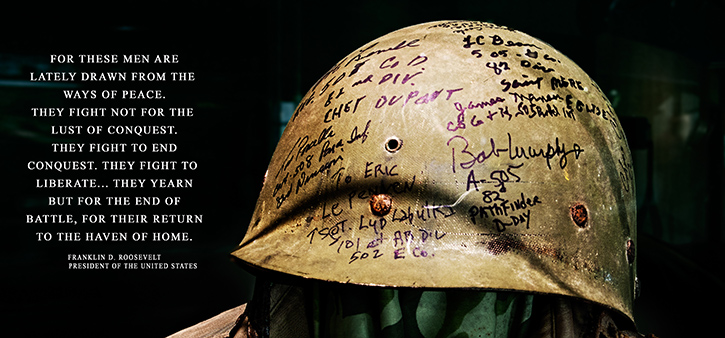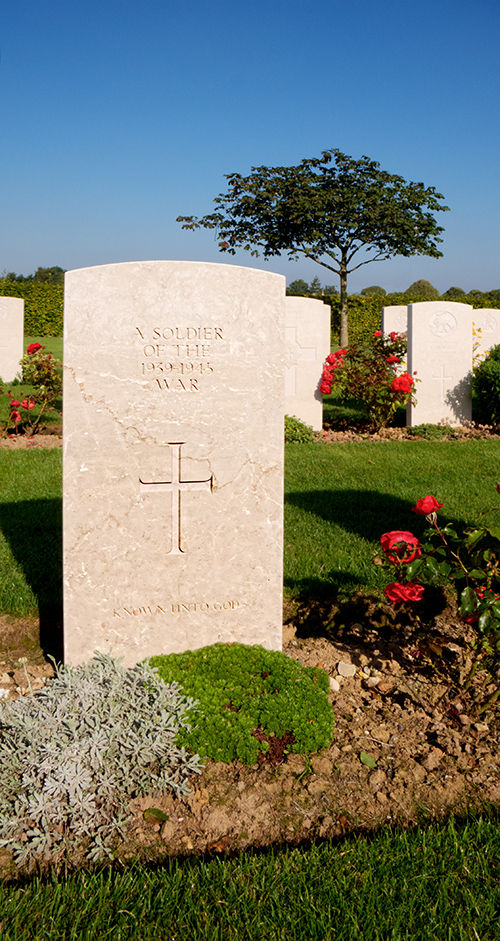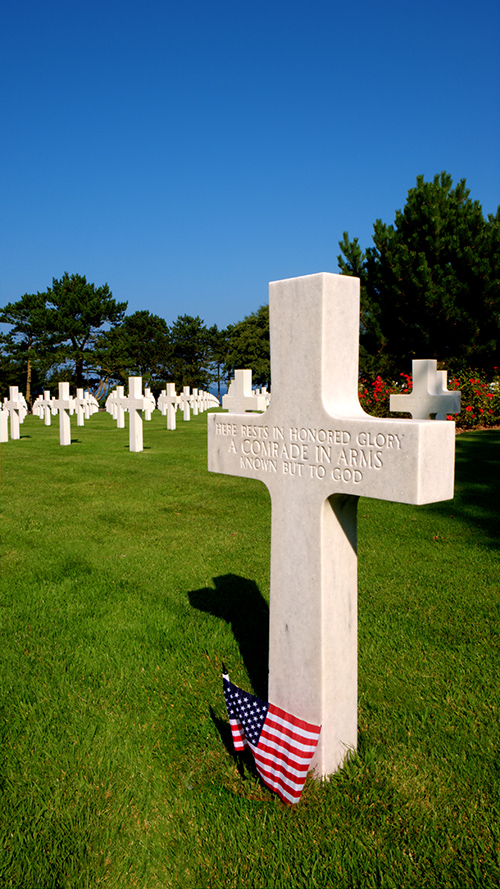Chapter 23: 1st lone travel (II) – war

Ever Forward – a Omaha Beach memorial from the surviving veterans and families to those who fell (click image to see complete, click here to see FDR quoted version).
If you want to know what this blog is about…
War
There is a reason I went to Normandy in this my first lone travel. War. I wanted to be able to take the time, to immerse myself in history without having to worry about boring anybody by my side. I wanted to pay homage to all those kids that lay down their lives so we could live in a better world. Few wars are as easy to understand and chose sides as WWII. Not many shades of grey. And those kids did die to give us a better world. So I thought I would go there, take my time and pay my respects. Thus, after that first night by Mont Saint Michel, I packed and moved base camp to Bayeux.
There are many ways to revisit history. You can be interested about strategy, equipment, numbers, armament, terrain… We live in a world that was for the last time reshaped as a result of two terrible World Wars, being the second a more or less direct consequence of the first. These wars have, no matter how we might ignore them,shaped our daily lives, and are one of the keys to understanding our world as it is. These wars are also part of our culture, of our collective imaginary from early childhood. Most of us have grown up whistling the tune on “The Bridge on the River Kwai” or “The Great Escape”, Darth Vader wears a helmet of unquestionable inspiration (will not use the n word), and the only things a kid can kill on his PlayStation without worrying his parents are zombies and WWII German soldiers.
As any other kid, I loved war movies, there were lots of them, they had tons of action, the good guys always won and the bad guys were always easily recognizable. You would see dogfights, tanks, machine-guns, destroyers, submarines… lots of huge war machines. Soldiers were always grown up men who, when shot, more than dying just got too tired to keep on living, spared a moment to make some profound reflection and then slept forever. War was amazing and fascinating, but also orderly, clean, proper. So cool…

US Paratrooper helmet signed by some of the men that jumped over Normandy on D-Day, just before dawn (click to enlarge).
Then I grew up. I think I was 16 when I saw Platoon and wondered at the fact that those soldiers were not actually men, not middle-aged grown up fathers, no John Waynes, no Richard Widmarks or Henry Fondas. They were just a little older than me, childish in many ways, and scared shitless. The image movies like this one offered was much more disturbing. It talked about young kids dying bad, alone, in fear.
Time went on, I got on in age and took to reading non-fiction, including war. I read about the wars, about the politics behind them, about the politicians behind these politics and about the soldiers. The mask fell with my blindfold and I saw war for what it is, a repulsive horror. I am no pacifist and I understand war can be unavoidable sometimes, but it is always terrible. I soon divided wars in three parts, the old men that cause them and then direct them, the young kids that fight and die in them, and the civil population, the people who live where the wars are fought and take the worst part of it.
War changed on the 20th century. First it became industrial and mechanic, then, after the bombing of cities like Gernika, Durango, Eibar and others on the Spanish Civil War, the civilian population became a primary target. However, my fascination remained focused on those kids that suffered and produced carnage on other kids. The ones that fill the massive cemeteries of WWI and WWII. And those, I went to visit. Of course, the kid in me wanted to see the tanks, the bunkers, the planes, everything, and I got my fill, but I will talk about all that in a different post.
Visiting the cemeteries
First thing I did when I reached Bayeux was visit the British War Cemetery. I wanted to walk at least one of them before going to the museums and sites because I wanted the kids to be present in my thoughts all the time. It is so easy to think about war, for us who have not lived one, without taking the dead, or the survivors at that, into account… we see the guns, the tanks, the cannons, the planes, but we tend to think that tanks shoot tanks and planes shoot planes, while all those war machines are always thought to kill young people. I visited Omaha Cemetery two days later and the sensations were similar, though different. I will try to explain what I felt, me being neither British nor American.
The first sensation I felt at Bayeux was gratitude. I do not mean my own, but that of those who take care of the cemetery. Everything was just perfectly taken care off. It surprised me not to be able to see the passing of the years. The cemetery could have been laid down the previous day. As I walked in, there are no walls, no barriers that I saw, I was overwhelmed by the numbers. Row after row of graves, gravestone after gravestone. You have seen this image, probably in Omaha, many times. Being there is a totally different experience. I knew what I was going to see but, it seems, I was totally unprepared to see it. So many. So real. And what made it all the worse, so young.
When Leonidas gathered his 300 Spartans to go fight the Persian invaders, he picked the men from among those who were fathers, for their line was already secured. What I was seeing there were the graves of hundreds, actually thousands, of kids in their early twenties, often teens, who had died before having a real chance to live. I thought of who I was at their age and then about my sons, and of the sons they never would have so mine could grow up free some day, and it was then when my own gratitude hit me. They had lost so much more than their lives. I felt so sorry for them…
When I went to the American Cemetery above Omaha Beach I knew what to expect, so it did not catch me unawares. However, Omaha Cemetery is eight times that of Bayeux and stands on top of a long hill, surrounded by trees, so when you walk into it you are isolated from the rest of the world. The rows upon rows of crosses are an overwhelming view and the cemetery reaches the horizon. Again, this cemetery could have been opened the day before. Most of the visitors were close to the entrance and the memorial, so I walked to the other edge, to be among those who get less visits. It was there that I walked among the crosses, looked at the names and took my pictures, slowly, in silence and in practical solitude.

The crosses of the kids resting in the south western quarter of the cemetery. Such a beautiful but terrible view (click to enlarge).
Two different ways to honor/honour
It surprised me to find that those two cemeteries are so much alike and yet so different. Those variations speak of the differences between British and U.S. cultures.
First thing is the space. Omaha Cemetery holds twice as many burials as Bayeux, but is like 8 times larger . The graves are much closer to one another, as well as the rows , in the British cemetery. Each American cross has twice as much room around it. Omaha has Christian crosses, or David’s stars, while the British used squarish rounded gravestones. There are fresh flowers on these gravestones while the American crosses have flags. There are only U.S. citizens in Omaha, while you can find many soldiers, some 500, from the Commonwealth and from outside it, Polish, Russian, Czech, even German enemies, in Bayeux. Each has a differently shaped gravestone.
As I said before, Omaha is isolated and silent, it is closed at night, and there are no benches beyond the memorial, nowhere to sit. Bayeux has grown around the war cemetery and made it theirs. It is more like a park. There are benches where I saw people reading, there is a road that goes by it, separated by a low hedge, there is a football field at the other side of another low hedge, so I guess kids get in to pick up footballs habitually, houses around, the civilian cemetery of Bayeux is like 200 yards away…
The sensation in Omaha is of respect and honor towards their heroes. The sensation in Bayeux is of honor and affection for their fallen chaps. Omaha is more halting, more respectful and more distant. Bayeux is more homely, less halting, but more affectionate. There is one single difference that made a deep impact in me and that I only found in Bayeux. While the American crosses are carved with, name, corps,date of death and state of origin, the British gravestones have the name, corps, date of death and age. For me, knowing the ages of the men buried under those graves was the most moving single element, and turned Bayeux in a cemetery of kids.
None of the two is better, this is not that sort of comparison. Each is best for the kids resting in it. I think one of these American kids would have felt too crammed in the British cemetery, while a British kid would have felt lonely in the American.When I think of myself, I think I would prefer to rest with the Brits, probably because I too live in a crammed land and prefer to feel bunched than lonely, but that is just me. I would be honored and am unworthy of sharing the ground next to any of these man in any event.
It was a bitter-sweet experience in both occasions. It was a touching experience, full of sadness and loss, frustrating as only the irreversible is, but I felt honoring/honouring them was the least thing I could do and I felt good afterwards, not for paying respects, but more for offering them some company, for a few minutes at least, and for having had a chance to show my gratitude to those kids.
I will return.
About the Pictures
There is something new about the shots I have been taking from early in the summer and all through the journey to Normandy. I have started shooting HDR panoramic compositions. That means shooting series of HDR images that I later merge into wide panoramas. I suppose lots of people are already doing this, but I have developed this technique on my own and, as far as I know, I might as well be the only one doing it. Haven’t checked if others are doing the same. The four panoramic shots are 5×5 HDRs. That is 5 shots of each of the 5 pieces that form the panorama that can be printed up to 108″ wide. The two vertical shots and the Ever Forward monument are also HDR. I did not shoot many pictures in Normandy. You can see them in my Normandy Gallery. There are a few 108″ panoramas there.
You can find lots of images like these in my galleries. My pictures can be printed in photo paper, canvas, metal or acrylic surface up to 108″ in many cases, or in greeting card format. You can check them by clicking the images above. I am all in for customizing pictures. All of them can be retouched in many ways, texts added, altered, changed or deleted. Ask freely.
Related Posts
5 Responses to Chapter 23: 1st lone travel (II) – war
Leave a Reply
« Chapter 22: 1st lone travel (I) – flying solo Chapter 24: 1st lone travel (III) – the cool stuff »














[…] Well, I lied… The first was about what it felt like to travel alone, the second about the war. The third was to be about all the cool stuff I saw in those experience-packed nine days. […]
Have I told you that I love your works? thank you for sharing these thoughs 🙂
Are you checking your medication on a regular basis? XD
Thank you, Anabelee 🙂
yesss, I have my pills 😛 and like those panoramics.
Now serious, I often visit cemeteries in my travels. They are very attractive to me and my camera. This affect that you talk about in the article, is present in all of them, even in those that look abandoned. And it reveals about the living more than about the dead.
True, cemeteries definitely tell us about the living.